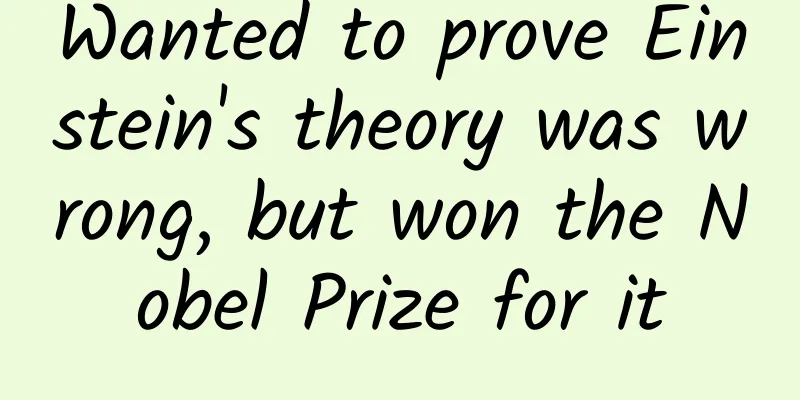Wanted to prove Einstein's theory was wrong, but won the Nobel Prize for it

|
It is said that the Nobel Prize Committee of the Royal Swedish Academy of Sciences made an exception and announced two award news at the same time at the end of November 1922: one was that the 1921 Nobel Prize in Physics was awarded to physicist Einstein in recognition of his explanation of the photoelectric effect. Second, this year's Nobel Prize in Physics was awarded to physicist Bohr in recognition of his research on the atomic structure of the microscopic world and his proposal of the atomic model theory. After the Nobel Prize Committee awarded them the prize, it immediately locked in the list of candidates for the 1923 Physics Prize: Robert Andrew Millikan, an American who had made major breakthroughs in the study of electrons in the microscopic world and in explaining the photoelectric effect. Millikan won the Nobel Prize. Image source: Physics Bimonthly Network one Rich kids have many talents Millikan's ancestors lived in New Zealand, and his parents moved to Illinois, USA. As the second son in the family, Millikan received a good education. His Chinese and math scores were excellent in elementary school, and he was considered a "child of other people's families." This laid a good foundation for his future development in many aspects. After entering Oberson College in Ohio, he first chose to study Greek and mathematics, and then changed to physics. In his sophomore year, he was appointed as a teacher in the physics preparatory class, teaching while studying on his own. Similar to the middle school teachers in my country in the 1980s and 1990s, junior high school graduates had to be the best of the best to teach junior high school students. Oberlin University had no physics textbooks, so Millikan volunteered to write a set of basic physics textbooks. This textbook was easy to understand and well-written, and was used by many schools. Millikan began to emerge. After graduating from college, an Illinois newspaper needed a reporter familiar with the law, and Millikan was invited to help. He incorporated legal knowledge into his articles, and his reports were humorous and to the point. While working as a reporter, he was asked to serve as a jury judge or defense lawyer, and his performance in court was very outstanding. Since then, Millikan has become famous in his hometown. If things had continued in this way, Millikan would have become an outstanding professor, writer or lawyer, but it would have been difficult for him to win the Nobel Prize in Physics. However, since he started teaching physics, he knew what he liked and where he should focus his efforts. This is what is called self-knowledge. two Oil drop experiment to measure charge In 1895, after a short stay in his hometown, the 27-year-old Millikan traveled to Europe at his own expense to study physics. After returning to the United States the following year, he reported to the University of Chicago to teach physics. Soon he was promoted to associate professor due to his outstanding teaching. In 1921, he was transferred to the California Institute of Technology as the head of the physics department until his retirement in 1946. While teaching at the University of Chicago, Millikan developed a keen interest in the microscopic world of matter and came up with the idea of measuring the charge of the electron. Millikan is doing an experiment. Source: Physics Bimonthly Network Human exploration of the microscopic world made a major breakthrough at the end of the 19th century: British scientist J. J. Thomson first proved the existence of electrons through experiments and measured the ratio between their charge and mass. This broke the mainstream view that "atoms are indivisible" that had been held for hundreds of years. After that, J.J. Thomson, Townsend, Wilson and other colleagues worked together to measure the charge of the electron. Because only by measuring the charge of the electron can its mass, trajectory, etc. be calculated. Unfortunately, there was little progress. In 1906, Millikan formally used Wilson's cloud chamber to measure the charge of electrons in water. However, the widely varying experimental results gave him a headache. A few years later, he discovered that the reason for the large variation in the measurement results was that the water droplets evaporated quickly, and therefore invented the balanced water drop method. This method is to electrify the water droplets in the cloud chamber to generate a reverse electric field force, so that the water droplets are suspended and the evaporation rate is slowed down. After repeated experiments, Millikan found that the difference between the experimental data was only reduced, and the actual problem was not solved. What to do? When he was at his wit's end, Harvey Fletcher, a graduate student working with him, suggested that other liquids could be used instead of water droplets. This awakened Millikan, and after careful consideration, he decided to use oil droplets instead of water droplets and redesigned the experiment. He first used two horizontally arranged metal plates (or battery packs) as the positive and negative electrodes, with two small holes on the metal plates, one of which was connected to a sprayer to spray oil droplets into the internal device, and the other was a microscope observation hole. The oil droplets sprayed into the plate gained electric charge due to friction, and under the action of the electric field force, they rose up to overcome gravity and floated in the air. The assistant adjusted the voltage to allow the oil drop to fall smoothly through the small hole to the observation area and then kept the voltage unchanged, while Millikan observed through a microscope. Oil drop experiment diagram After hundreds of observations, Millikan found that the total charge of all the oil droplets that floated into the observation area was an integer multiple of the same number. "This minimum charge value is the charge of the electron!" He felt that he had found the direction for a breakthrough. In order to get the data accurate, he and Fletcher took turns to carefully observe and record the movement of individual charged oil droplets, often staring at the oil droplets for several hours, which was very hard work. Hard work always pays off. In April 1912, Millikan calculated the basic charge e=(1.5924± 0.0017)×10-19 coulomb based on conclusive experimental data. This data is only 1% different from today's measurement result e=1.602176634×10-19 coulomb. The following year, Millikan published a paper in which he formally proposed the view that "any electric charge is an integer multiple of the basic charge." Detailed diagram of Millikan's oil drop experiment Source: Physics Bimonthly Network The elementary charge is the smallest amount of electricity in nature that has been experimentally measured. Its appearance has enabled the calculation of many physical constants to reach a higher precision, and Millikan became famous for this. Unfortunately, Millikan made two mistakes in his paper, which led to his oil drop experiment being criticized by later generations. First, the paper was not signed by Fletcher; second, the paper only listed 91 groups of observation results, and did not mention the 49 groups with large differences, which was seriously inconsistent with the statement in the paper that "it represents all oil drop experiments" (see "Millikan's Experimental Notebook"). III A surprise for photoelectric research Millikan was full of energy in his middle age. When Fletcher was concentrating on the oil drop experiment, he came up with an idea: to prove that Einstein's light quantum theory and photoelectric effect equation were wrong through experiments. After Einstein proposed the light quantum theory and established the photoelectric effect equation in 1905, according to the view at that time, it was quite difficult to accurately measure the photocurrent directly through experiments to verify the photoelectric effect equation. However, only by combining theory and experiment can the new theory be established. It was just because Einstein's light quantum theory was so rigorous and the photoelectric effect equation was calculated without error, so most scientists at the time accepted his theory, and only a small number of people, including Millikan, were skeptical. The experiment to prove the theory of light quanta is more difficult than the oil drop experiment. After all, oil droplets have a shape, but light cannot be touched or grasped. Millikan began his research in 1908, and it was not until 1912 that he designed the basic experimental device. However, during the experiment he gradually accepted Einstein's light quantum theory. In 1915, he finally designed a sophisticated device, confirmed the photoelectric effect equation, and calculated the value of Planck's constant h. Millikan's photon experiment. Source: Physics Bimonthly Network In 1916, Millikan published his research publicly. Since then, Einstein's light quantum theory has been verified, and Millikan also won the 1923 Nobel Prize in Physics for his outstanding research. END Tadpole Musical Notation original article, please indicate the source when reprinting Editor/Xiao Xitushuo |
>>: Hu Q&A丨What does growing taller have to do with it?
Recommend
What does the "Guang" in Guangdong and Guangxi refer to?
We all know that the "He" in Henan and ...
Can watching the sunset make you sick? Uncovering the mystery of "Sunset Syndrome"
Grandpa Li, 93 years old, suffers from Alzheimer&...
Sharks don't ride horses, but they can actually walk! | Nature Trumpet
Welcome to the 16th issue of the Nature Trumpet c...
Activity operation: an inventory of mainstream gameplay such as group buying, bargaining, and distribution!
Two boxers, "WeChat" and "Fission&...
The first lesson for parents to teach their children about financial literacy
Resources for parents’ first parent-child financi...
Market analysis of mobile advertising during the National Day holiday
The celebration of both National Day and Mid-Autu...
How to delete your own works on Bilibili? How to delete works on Bilibili
This article mainly introduces how to delete the ...
Case Study: Branding and IP-based Operation Practice of User Communities
Due to the impact of the epidemic, businesses are...
Advertising strategies in the circle of friends for the wedding planning industry!
1. Current situation of marriage planning industr...
Tesla's autopilot is unreliable. An accident only takes 1/8 of a second and leaves no trace.
With the development of technology, the driving a...
Low cost and high activity, how to recall users?
What I will talk about today is mainly related to...
APP promotion method: How to get downloads for free?
When promoting an APP, there is a method that is ...
Moon dust looks like this! The microscopic universe under the microscope
Electron microscope view of a diatom Silicon chip...
After studying the 5 subway screen-swiping incidents, I found an interesting thing
The subway is very busy this year and is often po...









